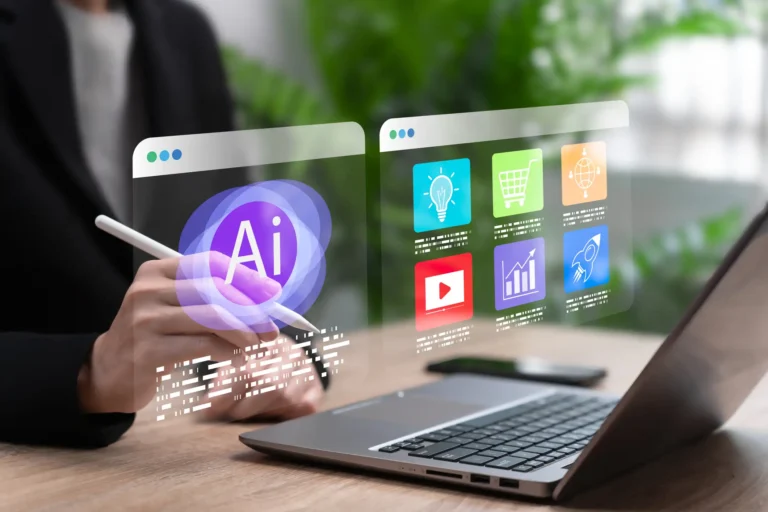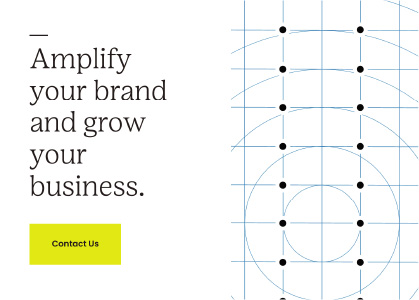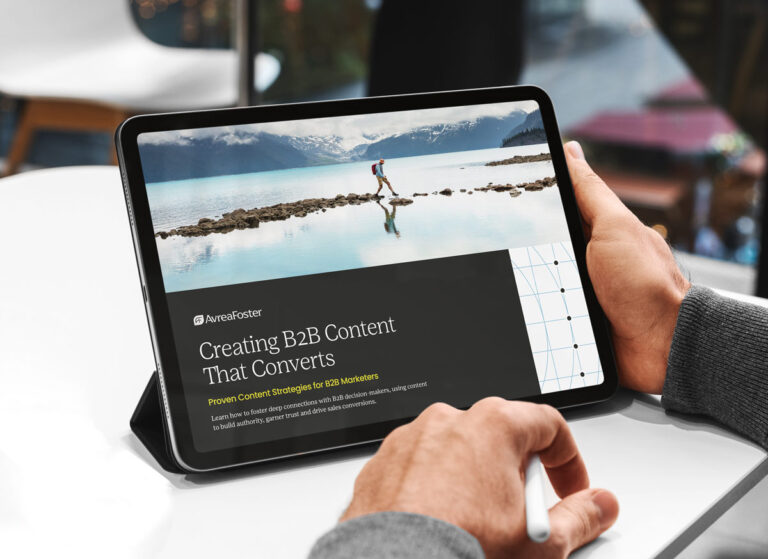In today’s increasingly complex world of B2B marketing, it takes more than a clever campaign or flashy website to drive real results. You need a marketing engine that continually engages prospects and turns them into clients — an engine that’s strategic, well-oiled and built to evolve.
At AvreaFoster, we’ve spent three decades helping B2B companies design and power marketing engines that generate leads, support sales and grow business. The marketing approaches may shift — we’re looking at you, ABM — but the core strategy remains the same: Meet buyers where they are and move them forward through the B2B marketing and sales journey.
In this article, we’ll walk through the essential parts of that B2B marketing engine — from digital platforms and messaging to outreach tools and technology.
Your Website: The Heart of Your Marketing Engine
Hands down, the most important sales and marketing tool for B2B marketers is your website. It’s the digital front door to your brand — and where most prospects begin their journey. More than just a storefront, your B2B website serves as your primary sales tool, your content hub and your lead generation engine — all rolled into one.
These stats tell the story:
- 93% of B2B buying processes begin with online research.
- B2B buyers are nearly 70% through their journey before contacting a seller.
- 78% of B2B buyers say an easy-to-navigate website is a key factor when selecting a vendor.
These numbers make one thing clear: A high-performing website isn’t optional — it’s essential. And creating a successful B2B website is both an art and a science.
The art lies in understanding your audience — shaping a digital experience that addresses their challenges and communicates your value through intuitive design and succinct messaging. The science involves embedding SEO best practices, using strategic keyword placement, optimizing metadata and employing clear calls to action and navigation paths to drive engagement and conversions. (Want to take a deeper dive into SEO? Check out our blog series: The Foundation of B2B SEO: Developing a Keyword Strategy That Works.)
Think of your website as the engine block; now it’s time to add the fuel that keeps it running. That’s where content comes into play.
Content Marketing: Fuel for the Journey
Sure, your website is a place to house your foundational sales, marketing and brand messages. But it’s the additional content — articles, guides, videos, case studies — that allows you to share your perspective, prove your expertise and connect with your audience.
In today’s B2B experience, content is the fuel that keeps prospects moving through the funnel. When crafting your B2B content marketing strategy, consider these content formats:
- News articles highlighting new product or service launches
- Blog posts that tackle industry trends or answer common questions
- Gated guides that are used in account-based marketing strategies
- Case studies that prove your impact
- Video content that introduces your team or simplifies complex solutions
During the web development process, make sure the structure supports your content strategy. Think about categorization, cross-linking and landing page workflows to keep users engaged. These are the assets that make up today’s B2B buyer’s journey.
Want to learn more about the fundamentals of content marketing? Download our guide: Creating B2B Content That Converts.
Email Marketing: Your Ongoing Conversation
Now that your content is created, it’s time to get it in front of the right people. Email marketing remains one of the most effective tools in a B2B marketer’s toolkit. According to the Content Marketing Institute, 81% of B2B marketers use newsletters as a primary content delivery method, and 87% rely on email to distribute content organically. Even more compelling, B2B email campaigns deliver an average return of $44 for every $1 spent.
Most B2B strategies include a combination of newsletters, lead-nurturing sequences tied to gated content and one-to-one sales outreach. To manage all of this effectively, most marketers rely on platforms like HubSpot or Salesforce. These marketing automation systems allow you to automate delivery, personalize messaging and track how recipients engage.
Marketing Tech Stack: Your Engine Control Center
Since we’re on the subject, let’s take a closer look at the technology that powers your marketing engine. From web development to campaign automation to lead scoring, today’s tech stack is essential for executing modern strategies.
Here are seven core components to consider:
- Content management system (CMS): Manages your website and blog content
- Customer relationship management (CRM): Stores and tracks leads and customer interactions
- Marketing automation: Streamlines email, social and lead-nurturing workflows
- Analytics and reporting: Measures performance and ROI
- SEO tools: Guide your search optimization efforts
- Ad management platforms: Oversee your paid digital campaigns
- Project management software: Helps teams stay aligned and productive
Want more? Read our article: Looking Under the Hood: 7 Components of a Modern B2B Marketing Tech Stack
Advertising: Reaching the Right Audience
So far, we’ve covered the foundational elements. Now let’s talk about how you get attention. In the past, B2B marketers used channels like print, radio and direct mail. While those still have a place, digital has taken center stage. According to eMarketer, digital B2B advertising in the U.S. is projected to grow from $18.34 billion in 2024 to $23.05 billion by 2026 — a 25.6% increase from 2024 to 2026.
Digital marketing allows for precision targeting and real-time tracking. Key channels include:
- Paid search: High-intent touchpoint where your brand shows up in relevant search results
- Paid social: Go-to channel for reaching professional audiences on LinkedIn, Meta and beyond
- Display ads: Visual format designed to build awareness and reinforce messaging across the web
- YouTube: Platform for delivering thought leadership and brand storytelling through video
- Connected TV (CTV): Growing channel for reaching decision-makers through streaming content
Want a deeper dive into even more B2B digital marketing channels? Check out: Eight Essential Digital Marketing Channels for B2B Success.
Organic Social Media: Extending Your Brand’s Reach
While paid advertising helps you get in front of the right people, organic social media plays a vital role in reinforcing your message and building long-term brand affinity. Social platforms are an important extension of your digital footprint, offering dynamic and controlled environments to share your story, connect with your audience and reinforce your B2B brand.
While LinkedIn is the go-to platform for B2B marketers, many companies also engage audiences on Facebook, Instagram, YouTube and X (formerly Twitter). These channels allow you to reach buyers where they scroll — creating opportunities to share content, showcase your team, highlight client wins and drive thought leadership. The value is clear: 90% of B2B marketers have distributed content on social media in the past year, proving it’s a key part of the content marketing mix.
B2B Trade Shows and Events: Real-Time Engagement
Events and trade shows remain an important touchpoint in the B2B space. They give you a chance to connect face-to-face and leave a lasting impression with B2B prospects. According to Trade Show Labs, 88% of businesses participate in trade shows to enhance brand awareness.
When planning your B2B trade show and event strategy, consider these marketing assets:
- Booth graphics and signage
- Printed handouts and brochures
- Promotional giveaways
- Pre-show emails and appointment-setting
- Real-time social coverage
- Post-show follow-up campaigns
B2B Sales Tools: The Closer’s Toolkit
- Sales brochures and one-pagers
- Customized pitch decks
- Product data sheets
- Case study PDFs
- ROI calculators or interactive demos
Final Thoughts: Keep the Marketing Engine Running
A successful B2B marketing engine isn’t built overnight. It requires strategy, coordination and the right tools working in harmony. From your website and content to your tech stack and outreach tactics, every piece plays a critical role.
At AvreaFoster, we specialize in helping B2B companies bring their marketing engines to life — and keep them running smoothly. Ready to tune up your marketing operation? Let’s talk.



